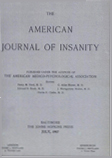A SURVEY OF METHODS USED TO PRODUCE "EXPERIMENTAL NEUROSIS."
Abstract
When the experimental conditions which led to behavior disturbances in the various species are compared, we find the following similarities:
1. In all the successful experiments, with the exception of those involving the chimpanzee and the cat, the subjects were restrained from making any very considerable gross bodily movement either by mechanical devices or by previous training to remain quiet.
2. With the same exceptions plus that of the food-getting response in the pig experiment, the learned responses in all the experiments were set up after the Pavlovian pattern.
3. In all the species experimented upon, a situation requiring a discrimination between two similar stimuli which evoked antagonistic behavior proved adequate to produce behavior disturbances.
4. Likewise, in all the species where it has been tried, i. e., the dog, the human child and the sheep, requiring the inhibition (or delay) of a response in the presence of excitatory stimuli to that response has proved to constitute an adequate precipitating situation.
Theoretical concepts have been advanced by various experimenters to account for the development of the behavior disturbances they observed. However, it is unlikely that any hypothesis thus far proposed will be comprehensive enough to account for all the facts we have described. While it is beyond the scope of this survey to evaluate and propose explanatory constructs, this has been attempted in a later paper.
Even if it were possible at such an early stage in the study of "experimental neurosis" to draw comparisons with and inferences for adult human behavior, this would, in the opinion of the writer, be an unwise procedure. It is his conviction that the contributions to be made to psychiatry by the study of this problem will be realized only after the total picture of the appearance and disappearance of experimentally-produced behavior disturbances has been described and understood. From this comprehension of the total process and not from comparisons of specific details should come valuable suggestions for explanatory concepts and therapeutic devices.
Access content
To read the fulltext, please use one of the options below to sign in or purchase access.- Personal login
- Institutional Login
- Sign in via OpenAthens
- Register for access
-
Please login/register if you wish to pair your device and check access availability.
Not a subscriber?
PsychiatryOnline subscription options offer access to the DSM-5 library, books, journals, CME, and patient resources. This all-in-one virtual library provides psychiatrists and mental health professionals with key resources for diagnosis, treatment, research, and professional development.
Need more help? PsychiatryOnline Customer Service may be reached by emailing [email protected] or by calling 800-368-5777 (in the U.S.) or 703-907-7322 (outside the U.S.).



